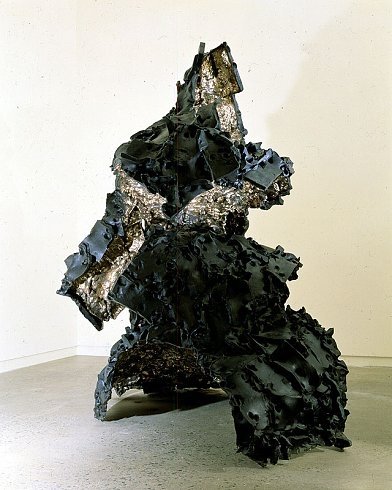Lynda Benglis
dal 18/11/2009 al 1/1/2010
Segnalato da
18/11/2009
Lynda Benglis
Cheim & Read, New York
The exhibition include large-scale bronze wall-hangings cast from urethane foam over wire, as well as free-standing non-objective sculptural forms. A refinement of Benglis's post-minimalist aesthetic, this body of work represents a synthesis of the artist's critical sensibility and her interest in the physicality of sculptural materials. Her hybrid forms display attributes that have less to do with the frozen quality of painting and sculpture than with the memory of the body in motion.

Cheim & Read is pleased to announce an exhibition of new work by Lynda Benglis, including large-scale bronze wall-hangings cast from urethane foam over wire, as well as free-standing non-objective sculptural forms. A refinement of Benglis's post-minimalist aesthetic, this body of work represents a synthesis of the artist's critical sensibility and her interest in the physicality of sculptural materials.
Born in Louisiana, Benglis moved to New York in the late 1960s, just after minimalism had reached its zenith. She and other artists of the period challenged one of the essential premises of the male-dominated minimalist movement: that human perception opens onto to rational truths. In an infamous Artforum ad from 1974, Benglis poses nude with sunglasses on and a dildo between her legs to make a raucous joke of the ostensible self-sufficient minimalist artist and object alike.
For all its cool refinement, Benglis's most recent work is no less committed to the critique of art's institutionalization within the gallery, museum and academy. The pieces shown at Cheim & Read – not so much sculpture as sculptural – challenge through their materials and forms the basic categories that artists, patrons, and critics rely on to understand and evaluate art. For instance, Benglis's monumental wall hangings are neither painting nor sculpture, but a hybrid of the two, maintaining a frontal orientation while projecting outwards into space. More importantly, though, these hybrid forms display attributes that have less to do with the frozen quality of painting and sculpture than with the memory of the body in motion. The remembered body in question coincides with the artist's own physical engagement with the wire and foam, from which the bronze casts are taken. In the finished works, a contradiction manifests between the hard permanence of the metal alloy and the fleetingness of the bodily gestures. One can no more easily decide as to whether these pieces are light or heavy, soft or hard, fugitive or stable, than one can label them definitively painting or sculpture.
Likewise, the tall and narrow stainless steel "totems", which have been cast from wax models, memorialize with surprising intimacy the touch of the artist's fingers, seducing the viewer into an imaginative identification with the artist herself. The massive orange urethane hemispheres similarly record the processes of their making: in this case, the accumulation of material substance. As much as these works stand-in for process, they, too, like the bronze wall hangings, court the specter of absence, for the moment of their creation has already passed.
Accordingly, then, by bringing the processes of artistic production into the interior of the aesthetic end-product, Benglis creates sculptural forms that insist upon the fact of their own contingency, as they foreground their own inevitable failure to exist apart from the specific, embodied actions of the artist herself, whose artistic pursuits must always be limited by historical and cultural horizons of possibility.
Benglis succeeds in delivering a perspicuous critique of art in the age of the culture industry by refusing to submit her work to the institutional imperatives of isolation, categorization, and quantification. And, even more significantly, she has done so on purely aesthetic grounds, in works that are frankly beautiful, and by means of nothing more than formal relationships and the play of materials. It is almost as though all the wit and defiance of the Artforum ad from a quarter of a century ago have been distilled and purified into the very substance of the aesthetic object itself, which, despite itself, in Benglis's hands, negates the possibility of its own self-containment. In this light, 1974 seems very far away indeed.
Lynda Benglis divides her time between New York and Santa Fe. Her numerous awards and honors include a Guggenheim Fellowship and two National Endowment for the Arts grants. She is currently the subject of a traveling retrospective exhibition, organized by the Irish Museum of Modern Art.
Image: CLOAK-WAVE / PEDMARKS, 1998 Bronze, black patina 85 1/2 x 86 x 42 1/2 inches 217.2 x 218.4 x 108 centimeters. Edition of 3
Opening Thursday 19 November from 6 to 8 pm
Cheim & Read
547 West 25th Street New York, NY 10001
Hours:
Tuesday - Saturday 10 am - 6 pm



